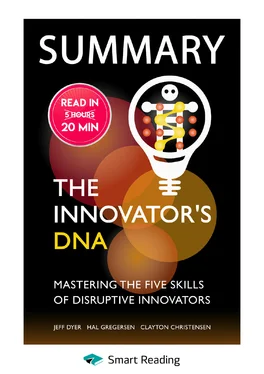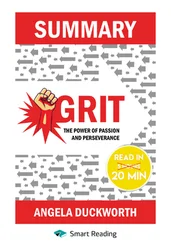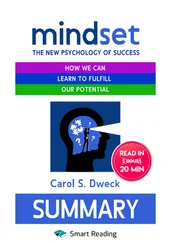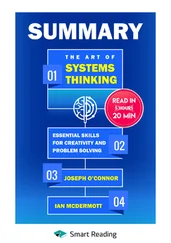Summary: The Innovator’s DNA. Mastering the Five Skills of Disruptive Innovators. Jeff Dyer, Hal Gregersen, Clayton Christensen
Автор:
Jeff Dyer, Hal Gregersen, Clayton Christensen
Оригинальное название:
The Innovator’s DNA. Mastering the Five Skills of Disruptive Innovators
www.smartreading.ru
Anyone Can Be an Innovator
In recent years, many books have been published on creativity and innovation in business. But there is a problem: the leaders of large organizations have no idea that it is possible to think differently. This is not taught in business schools. MBA programs explain how to become providers of goods and services, but not researchers.
The Innovator’s DNA book is the result of an eight-year study of disruptive innovators and the innovative companies they established. The authors interviewed hundreds of creators of successful projects and products, leaders, and founders of revolutionary companies. Their answers helped us understand where breakthrough ideas come from.
It turns out that the behavior of innovative entrepreneurs and leaders is largely similar. Firstly, their thinking skillfully connects various things, thoughts, and phenomena, which leads to the creation of unique ideas. In addition, all innovators excelled at questioning, observing, networking, and experimenting.
People think that creativity is a cognitive skill, however the ability to create innovative ideas is not only derived from your brain, but also from your behaviors.Thus, by changing your behavior, you can improve your creativity. Innovative companies are always led by innovative leaders, so if you want to create something truly new, you first need to be creative.
What makes innovators different?
Many people are convinced that people are endowed with creativity by nature: it’s just that some people’s right hemisphere is better developed and, as a result, so it their intuition. However, research results disprove this misconception.
The most comprehensive study of the origin of creativity was done by a group of researchers, Merton Reznikoff, George Domino, Carolyn Bridges, and Merton Honeyman. They studied the creative abilities of 117 pairs of twins aged 15 to 22 and found that only about 30 % of the creative activity of identical twins had a genetic origin. In contrast, roughly 80 to 85 percent of the general intelligence (IQ) tests could be attributed to genetics.
So general intelligence is basically a genetic endowment, but creativity is not. About two-thirds of innovative skills are acquired during the learning process. Our environment also affects our ability to develop creativity. Societies that promote community versus individualism and hierarchy over merit – such as Japan, China, Korea, and many Arab nations – are less likely to innovate or produce a Nobel Prize winner.
The authors of this book studied about 500 innovators out of 5,000 heads of companies and were able to identify five discovery (research) skills that distinguish innovators from ordinary leaders. First and foremost, innovators count on a cognitive skill that we call "associational thinking" or simply "associating". Other discovery skills, questioning, observing, networking, and experimenting, are all behavioral in nature.These discovery skills, combined with innovative courage, form the innovator’s DNA model, or the source code for generating innovative business ideas.
Discovery Skill No. 1. Associating
Associating happens as the brain tries to synthesize and make sense of novel inputs. It helps innovators discover new directions by making connections across seemingly unrelated questions, problems, or ideas. Innovative breakthroughs most often happen when diverse disciplines and fields, which ordinarily people would never guess to combine, indeed intersect.
To understand how associating works and why some people excel at it more than others, we need to understand how the brain works. Information in the brain is organized in a completely different way than in a dictionary, where words are arranged in alphabetical order, owing to which you will always find the word "theater" among words that begin with the letter T. In the human brain, this word is associated not only with words starting with the letter T, but also with other information points. Some associations are logical: "Bolshoi", "entr’acte" or "opening night". Others are less obvious, such as "kissing", "career", or "anxiety". The more diverse information stored in the brain is, the more associations arise during the "uploading" of fresh information. New knowledge triggers associating, which leads to the creation of innovative ideas. The associating muscle can be developed through active questioning, observing, networking, and experimenting.
You can stimulate associating using the following methods:
▶Creating unusual combinations– innovators often try to combine seemingly completely unrelated ideas and create unique combinations. They make pairs, triplets, and quadruplets of ideas, asking the questions: "What if we put this and that together?" or "… mix this, this and this with that one?" They think differently, while fearlessly creating unfamiliar combinations of ideas.
Google founder Larry Page combined two completely different ideas – Science citation and Internet searches – to launch Google. As a graduate student at Stanford, Page knew that scientific journals rank scientists by the number of citations in the past year. He realized that if Google sorted websites in the same way (by most visited), then Internet users would get more user-friendly search results.
▶Zoom in and out– innovative entrepreneurs often dive deep into the details to see the specifics of the customer experience, and "take a bird’s eye view" to see how the details fit into the big picture.
Steve Jobs used the "zoom in" approach when he worked with his team on the design of the first Macintosh computer. He went to a shopping center and carefully studied various plastic devices. One day he saw a food processor, which gave him the idea for a design of a computer. Jobs also used the "zoom out" method. The creation of the famous iTunes, iPod, iPhone, and iPad would hardly have been possible without the Apple founder’s departure from his company and the subsequent acquisition and successful management of Pixar. Thus, Jobs managed to see the media industry as a whole, studied Apple from with an outside-looking-in vantage point, and only after that was he able to create many breakthrough projects.
Конец ознакомительного фрагмента.
Текст предоставлен ООО «ЛитРес».
Прочитайте эту книгу целиком, купив полную легальную версию на ЛитРес.
Безопасно оплатить книгу можно банковской картой Visa, MasterCard, Maestro, со счета мобильного телефона, с платежного терминала, в салоне МТС или Связной, через PayPal, WebMoney, Яндекс.Деньги, QIWI Кошелек, бонусными картами или другим удобным Вам способом.












